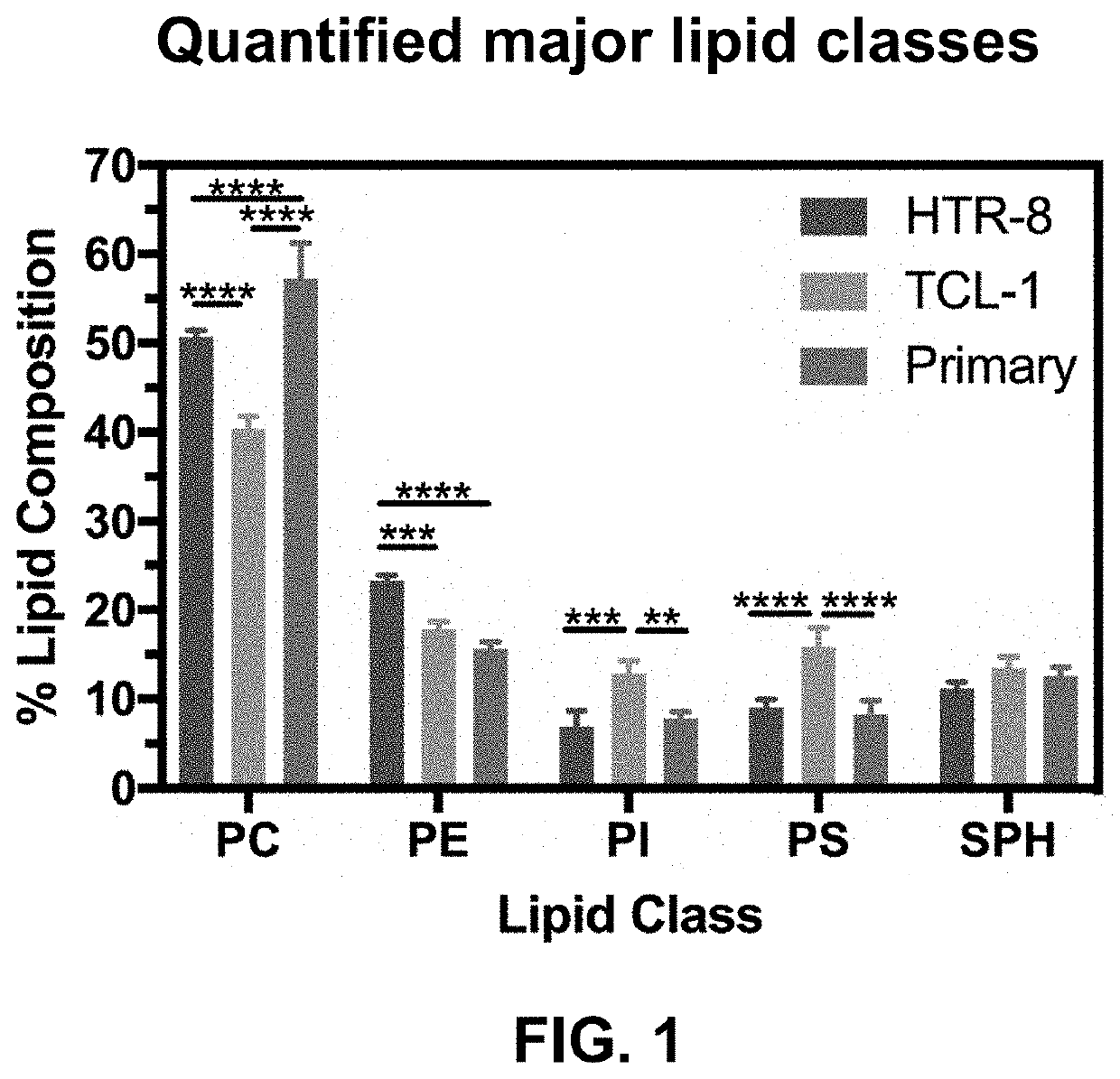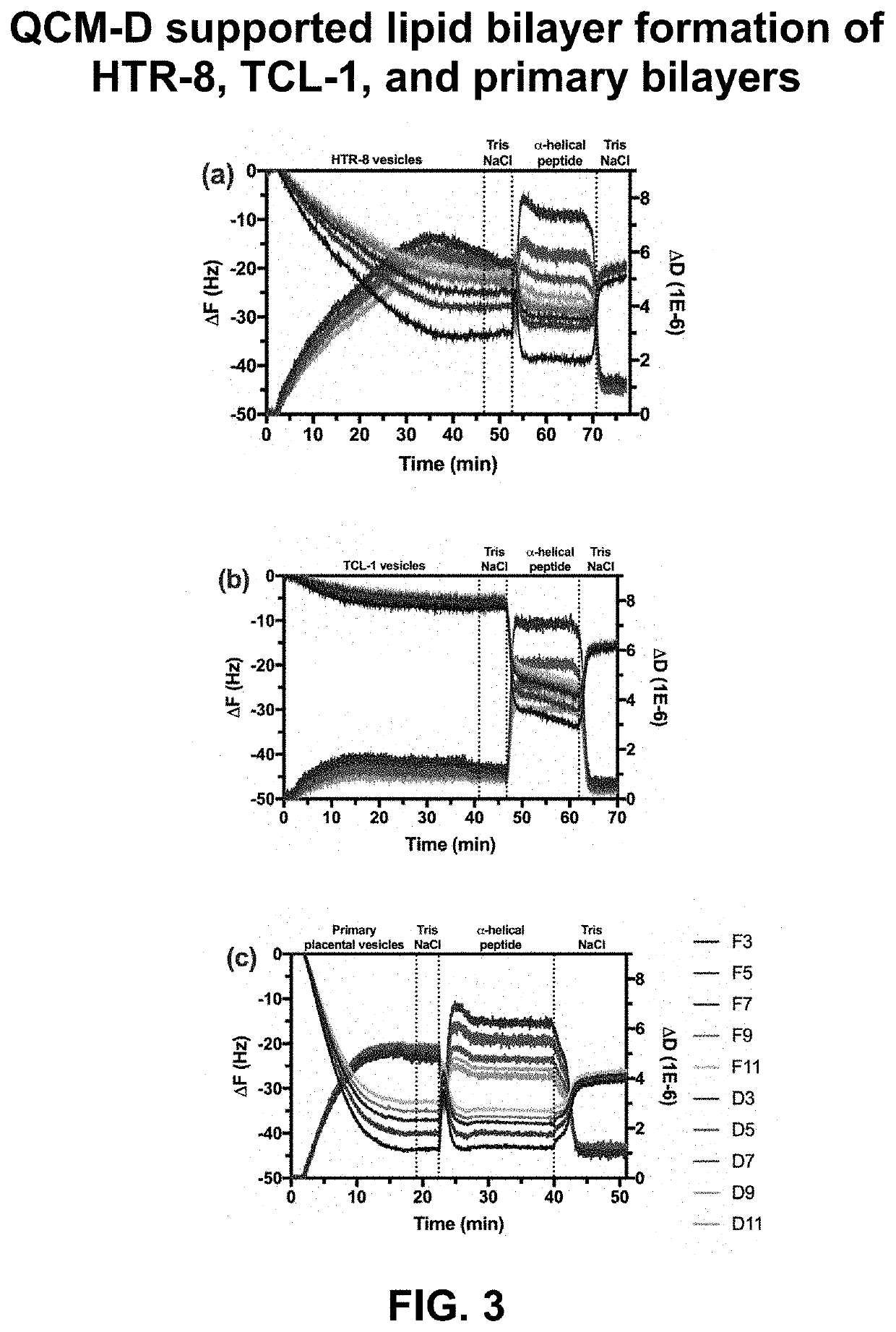Placental lipid bilayer for cell-free molecular interaction studies
a lipid bilayer and molecular interaction technology, applied in the field of heterogeneous membranes, can solve the problems of difficult study, increased perinatal and neonatal mortality, and difficult placental dysfunction, so as to minimize the risks of a developing fetus, improve the understanding of the placenta, and improve the effect of treatment plans
- Summary
- Abstract
- Description
- Claims
- Application Information
AI Technical Summary
Benefits of technology
Problems solved by technology
Method used
Image
Examples
example 1
Synthetic Placenta Lipid Membranes for Nanomaterial Interaction Studies
[0095]Rationale. The goal of this EXAMPLE 1 is to provide an in vitro system to monitor molecular interactions with a synthetic placental bilayer. A supported lipid bilayer (SLB) was developed from synthetic lipids mimicking the placenta cell membrane for adsorption and mass loss studies. Supported lipid bilayers are a useful tool to investigate adsorption or mass removal interactions occurring. To gain more information, the inventors developed suspended lipid bilayers across PVDF porous inserts. This development produced a parallel artificial membrane permeability assay (PAMPA) to investigate further DEHP, amphotericin B, and amBisome® interactions with HTR-8, TCL-1, and primary lipid models. The PAMPA studies can be used for permeation.
[0096]Analytical approach. First, the inventors used a reported composition to develop placental lipid bilayers. Previous studies have extracted lipids from placental tissue and ...
example 2
Trophoblast Cell Line-Derived Placental Lipid Vesicles and Lipid Bilayer
[0104]Rationale. The goal of this EXAMPLE 2 developed a lipid bilayer from trophoblast cell-extracted lipids. Trophoblast cells, specifically the BeWo villous trophoblast cell line, have been used to study maternal-fetal transport. Ali et al., Int. J. Pharm., 454(1), 149-157 (2013). The inventors are developing bilayers from the lipids extracted from the established BeWo villous trophoblast cell line. The inventors are comparing the bilayers with the synthetic composition from EXAMPLE 1.
[0105]Analytical approach. Lipid extraction from trophoblast cells. Quantification of lipids in BeWo trophoblast cells. The inventors first collected BeWo trophoblast cells, then solubilized and agitated the BeWo cell pellet. They next analyzed the lipid composition by gas chromatography. The lipid extracts are processed through the dry lipid film method and extrusion, as performed in EXAMPLE 1.
[0106]Cell-derived lipid vesicle an...
example 3
Tissue-Derived Placental Lipid Vesicles and Lipid Bilayer
[0111]Rationale. The goal of this EXAMPLE 3 is to extract the lipid composition from placental tissue, quantify this extract, and use it to develop placental lipid bilayers. This aim is also to allow comparison of the lipid composition with the placental cell lines, which has not previously been investigated.
[0112]Analytical approach. Lipid extraction from placenta tissue. Quantification of lipids in placenta tissue. The Women & Infants Hospital of Rhode Island kindly provided human placenta tissue samples to the inventors obtain for them to homogenize. The homogenized tissue is processed similarly to the processing of the BeWo cells, to extract the lipids using liquid-liquid extraction. The extracted lipids then went through the dry thin-film method and extrusion described in EXAMPLE 1 to obtain placental tissue-derived lipid vesicles. Both supported lipid bilayers and PAMPA are formed and characterized by the methods describ...
PUM
| Property | Measurement | Unit |
|---|---|---|
| hydrodynamic diameter | aaaaa | aaaaa |
| frequency | aaaaa | aaaaa |
| size | aaaaa | aaaaa |
Abstract
Description
Claims
Application Information
 Login to View More
Login to View More - R&D
- Intellectual Property
- Life Sciences
- Materials
- Tech Scout
- Unparalleled Data Quality
- Higher Quality Content
- 60% Fewer Hallucinations
Browse by: Latest US Patents, China's latest patents, Technical Efficacy Thesaurus, Application Domain, Technology Topic, Popular Technical Reports.
© 2025 PatSnap. All rights reserved.Legal|Privacy policy|Modern Slavery Act Transparency Statement|Sitemap|About US| Contact US: help@patsnap.com



